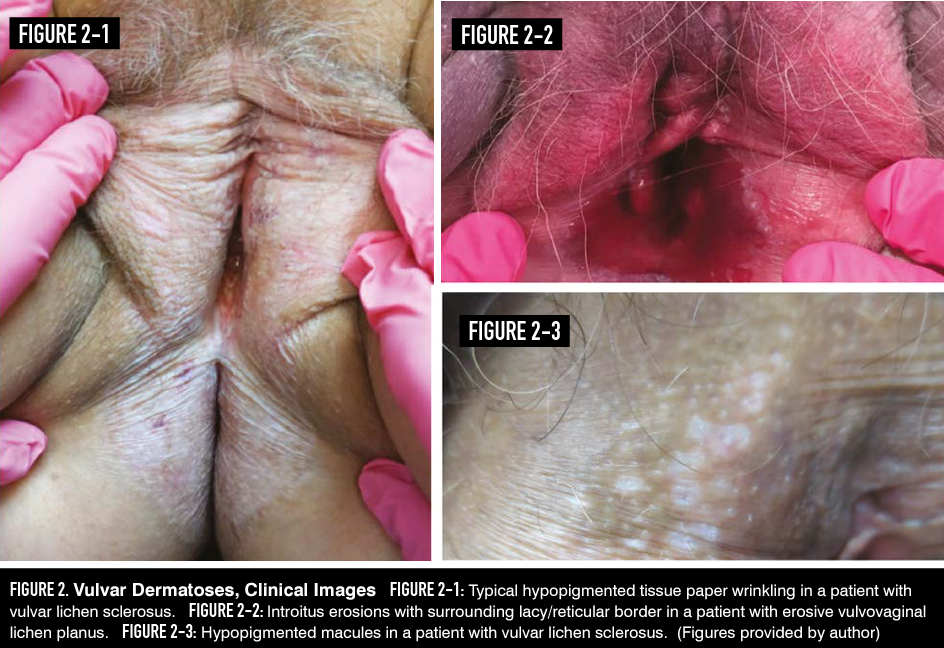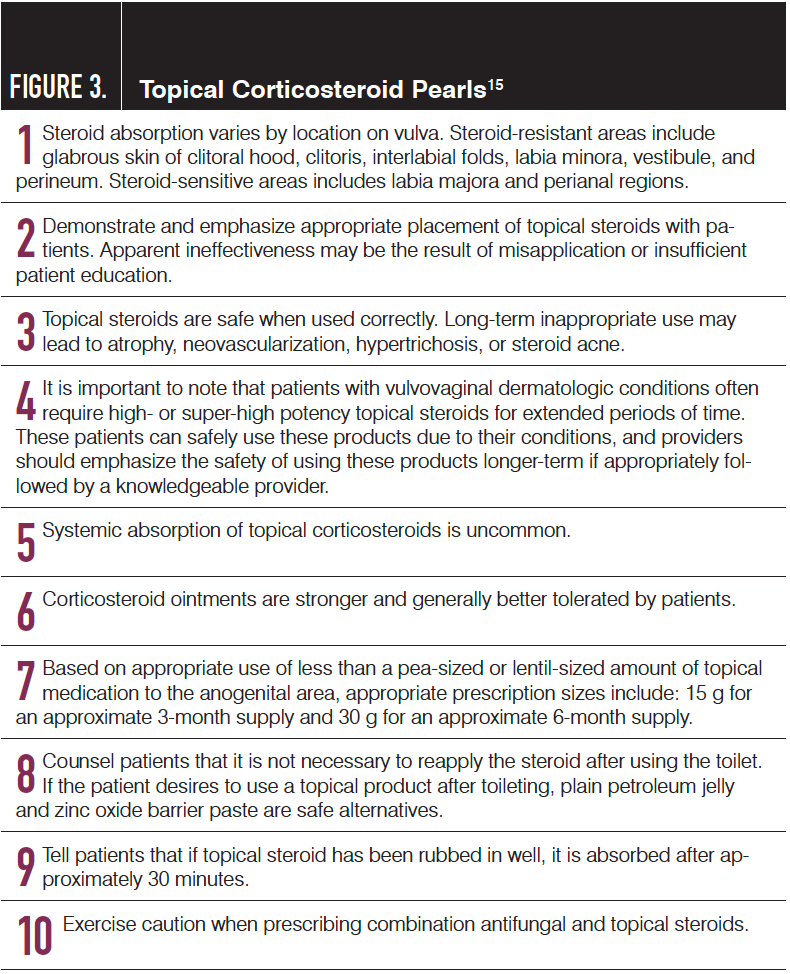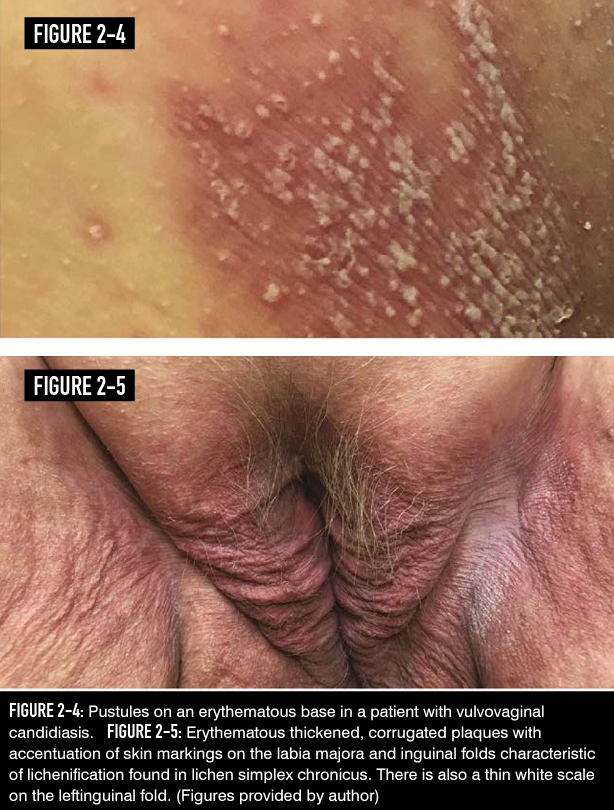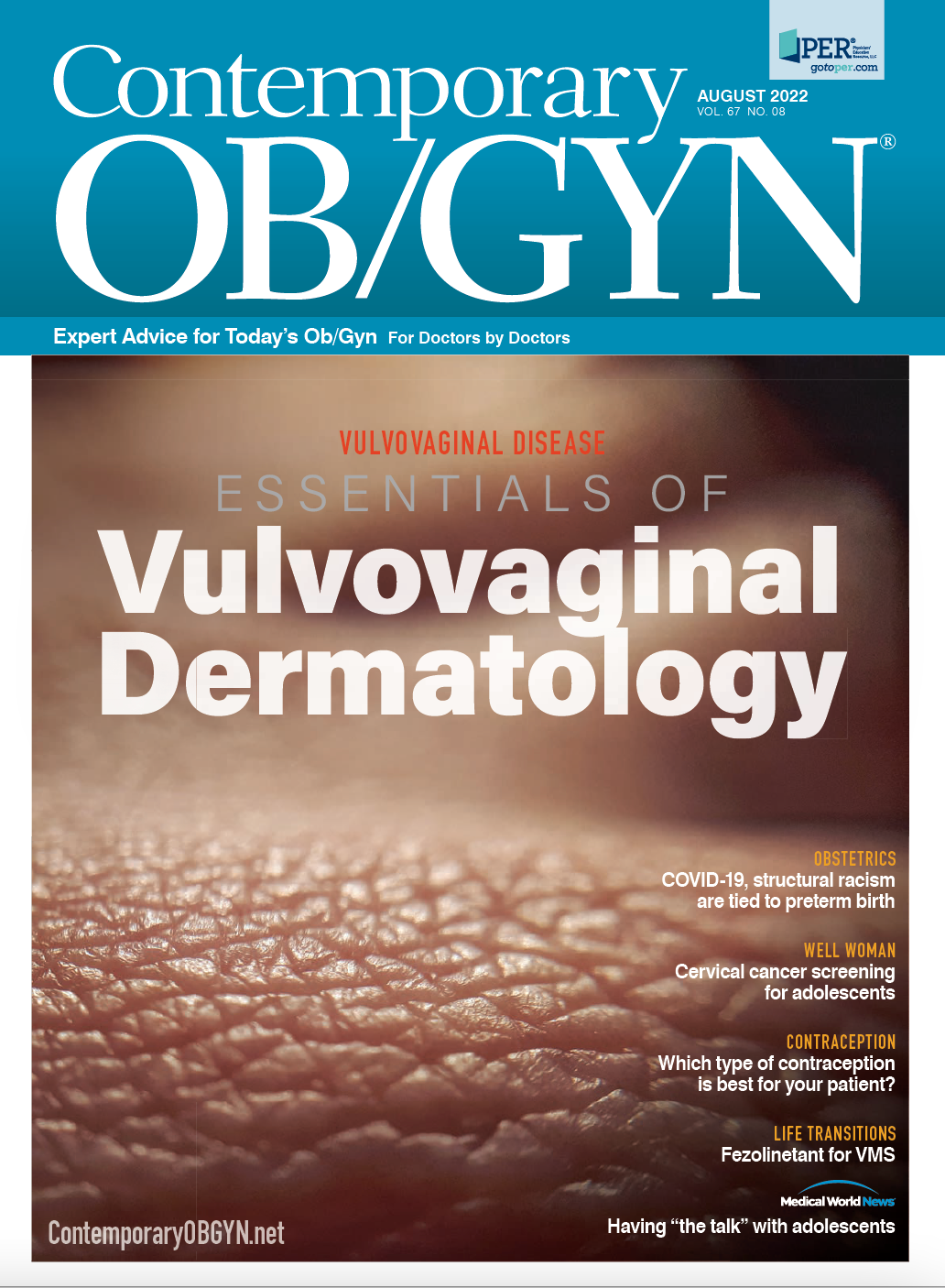Essentials of vulvovaginal dermatology
Correct terms and education can help normalize the conversation for patients.
Recognizing and appropriately managing common vulvar conditions is essential to preserve patient quality of life and prevent irreversible architectural sequelae. Patients with vulvar dermatoses often report a significant delay from symptom onset to diagnosis. This delay is multifactorial and includes patient and provider reluctance to discuss vulvovaginal or other intimate symptoms. In addition, most women do not examine their vulvas.
Results of a study showed that only 15% of participants were able to correctly sketch vulvar anatomy, 67% had not heard of vulvar self-examination, and 61% approached their genitalia with feelings of shame and embarrassment.1 It is important that providers be comfortable initiating these conversations to prevent diagnostic delay and to give patients accurate information and timely treatment.
Lichenoid conditions
Using the correct terms allows providers to develop a wide differential diagnosis (Figure 1). An important concept in vulvovaginal dermatology is lichenoid eruption, a diverse group of inflammatory skin diseases sharing common morphology and/or histopathology. Distinguishing among the various lichenoid conditions of the genitalia, including vulvar lichen sclerosus (VLS), vulvovaginal lichen planus (VLP), and vulvar lichen simplex chronicus (LSC), is important because optimal treatments vary.
Although all 3 conditions may present primarily with pain or pruritus, features such as anatomic involvement, risk factors, and associations may differ. VLS and VLP are primary cutaneous disorders, whereas vulvar LSC is a secondary skin condition resulting from another underlying dermatosis, infection, or psychological or neurologic condition. VLS primarily affects external genitalia, whereas VLP may affect both the vulva and vagina.
Vulvar lichen sclerosus
VLS is a chronic, often progressive dermatologic condition that involves the anogenital region. The prevalence of VLS is not well established, though it is likely an underrecognized and undermanaged condition. Results of large cohort study showed an estimated prevalence in the United States of 0.05%, with 79% of diagnoses in women between the ages of 45 and 65 years but 16% of diagnoses in women between the ages of 18 and 44 years.2 Most patients present with vulvar pain, pruritus, or irritation, but patients may be asymptomatic. Patients eventually diagnosed with VLS may have yeast infections for years (Figure 2-1).
Figure 2. Vulvar Dermatoses, Clinical Images
FIG 2-1: Typical hypopigmented tissue paper wrinkling in a patient with vulvar lichen sclerosus. FIG 2-2: Introitus erosions with surrounding lacy/reticular border in a patient with erosive vulvovaginal lichen planus. FIG 2-3: Hypopigmented macules in a patient with vulvar lichen sclerosus. (Figures provided by author)

Early detection of VLS is critical to preventing irreversible architectural sequelae and vulvar squamous cell carcinoma (SCC). Skin changes that may be evident upon vulvar inspection include white, atrophic papules that may coalesce into plaques, often affecting the labia minora or majora (Figure 2-2, Figure 2-3).
Early VLS may have a nonspecific presentation, so a high degree of suspicion must be maintained. Varying degrees of architectural change may be present in later disease stages. It is important to note indurations and small erosions, which could be signs of SCC, even in younger patients. First-line treatment is early use of a superpotent topical corticosteroid with continued topical corticosteroid for maintenance therapy. Patient education emphasizing treatment adherence is critical. In a study that spanned 8 years, patients adherent to topical corticosteroid treatment did not develop SCC or precursor vulvar intraepithelial neoplasia (VIN), and adhesions and scarring developed in only 3% of patients.3 Reports of symptomatic control also were higher in adherent patients. In contrast, in patients only partially adherent with treatment, 5% developed SCC or VIN and 40% developed adhesions
and scarring.3
Vulvovaginal lichen planus
VLP is an inflammatory condition and subtype of lichen planus (LP) that most commonly affects women between 50 and 60 years of age.4,5 Although the incidence and prevalence of VLP is unknown, most women with LP have genital lesions.6 Most frequently, patients will present with soreness, pruritus, or genital burning.
Allergic and irritant contact dermatitis of the vulva
Allergic and irritant contact dermatitis (ACD/ICD) frequently occur concomitantly with other vulvar conditions as preexisting dermatosis impairs skin barrier function. In patients with vulvar ACD, the most common concomitant vulvar diagnoses are VLS followed by LSC.10 This may complicate the clinical picture and lead to diagnostic and management delays. Therefore, vulvar ACD/ICD should be considered when patients with vulvar disease are not improving with standard treatment.
Vulvar ICD may occur acutely or, more commonly, chronically. Symptoms in vulvar ACD may become apparent 1 to 2 days after allergen exposure, but commonly the exposure is unrecognized and may only slowly produce symptoms and eruption. This frequently leads to difficulty in identifying the culprit allergen. Patients with ACD/ICD often present with nonspecific vulvar pruritus or burning. Skin changes in vulvar ACD/ICD are similar and include erythema, edema, vesicles, bullae, and oozing. Thus, clinical differentiation of vulvar ACD/ICD is not reliable. The diagnosis of vulvar ICD is based on history and establishment of a potential irritant, whereas vulvar ACD may be established with patch testing.
Patients with vulvovaginal symptoms have often tried various topicals for symptom resolution before seeking medical attention. Common vulvar irritants include body fluids, hygiene or personal care products, heat, excessive bathing, medications, soaps, and detergents.11 The most commonly identified allergens in ACD are fragrances, preservatives, and medications including neomycin and topical anesthetics.10,12,13 Patients may have an allergy to topical corticosteroids,10,14 which are an important first-line treatment for many vulvar dermatoses (Figure 315).
Figure 3. Topical Corticosteroid Pearls.15

ACD/ICD treatment includes discontinuing potential irritants and allergens, using petroleum on erosions, and educating patients. Patients should be counseled on the importance of cleaning the vulva with lukewarm water without harsh or fragranced soaps, cleansers, or detergents, and using sitz baths for additional symptomatic relief. Topical corticosteroid ointments may be used in severe or chronic disease, and antihistamines may be used for pruritus. Patients may benefit from a dermatology referral for patch testing to identify possible culprit allergens, which is a more appropriate testing modality to identify contact allergens than the skin prick test commonly performed by allergist physicians.
Lichen simplex chronicus
LSC is a reactive skin disorder secondary to chronic skin rubbing or scratching, often in response to persistent pruritus or irritation, regardless of primary problem. It results in secondary changes of skin including thickening and lichenification (Figure 2-5), with a moderately well-defined scaly plaque. Patients with other vulvar dermatoses often develop LSC in response to chronic scratching. Patients with LSC can pose a diagnostic challenge as primary skin conditions cannot be appropriately diagnosed until there is improvement in LSC symptoms and cutaneous changes. LSC is typically a clinical diagnosis, and management centers on disrupting the itch-scratch cycle, in which pruritus leads to scratching, which perpetuates and worsens inflammation. First-line medical treatment often includes a short course of medium-potency topical corticosteroid to promote active lesion resolution. Upon treatment of LSC, an underlying primary vulvovaginal dermatosis may be more readily identifiable and addressed.
FIGURE 2-4: Pustules on an erythematous base in a patient with vulvovaginal candidiasis. FIGURE 2-5: Erythematous thickened, corrugated plaques with accentuation of skin markings on the labia majora and inguinal folds characteristic of lichenification found in lichen simplex chronicus. There is also a thin white scale on the leftinguinal fold. (Figures provided by author)

Genitourinary syndrome of menopause
Genitourinary syndrome of menopause (GSM), formerly called vulvovaginal atrophy or atrophic vaginitis, refers to a collection of signs and symptoms that occur in menopausal women secondary to decreased stimulation of estrogen-sensitive tissues, including the vulva, vagina, urethra, and bladder. GSM is very common. In fact, vulvovaginal symptoms occur in 39% to 51% of postmenopausal women, with the majority having moderate to severe symptoms, and one-third stopping sexual activity because of their symptoms.16 Unfortunately, many women do not recognize vulvovaginal atrophy and are reluctant to discuss vaginal or sexual symptoms with health care professionals.16 Most women with GSM believe that their vaginal symptoms are a normal part of aging.16 Symptoms seen in GSM include genital dryness, discomfort, burning, dyspareunia, dysuria, urinary incontinence, and recurrent urinary tract infections. Physical changes may include a vaginal epithelium that is a paler pink hue with decreased rugation, diminished pubic hair, decreased turgor and elasticity of the vulva, and minimization of the labia minora. GSM is a clinical diagnosis. Women have a strong desire for health care professionals to initiate conversations regarding GSM.16 First-line treatment includes vaginal moisturizers, personal lubricants, and low-dose vaginal estrogen. Of note, multiple studies have shown no increase in risk of cardiovascular disease or cancer with low-dose vaginal estrogen use.17,18 In addition, low-dose vaginal estrogen has minimal systemic absorption and does not increase plasma estradiol to premenopausal levels, study results show.19 In cases of advanced symptoms, pelvic physical therapy may be beneficial, particularly for urinary incontinence
and dyspareunia.
Talking to a patient about vulvovaginal concerns
Figure 4. Intake Questionnaire, Select Example Questions20

Before the clinic visit, intake questionnaires provide the patient with space to answer sensitive questions (Figure 420). During evaluation, review the patient’s hygienic practices and product usage. Patients should be asked whether they engage in a vulvar washing or cleaning practice. In our society, where patients unfortunately are taught that their vulvas are unclean, patients may believe that symptom resolution is only a matter of washing more thoroughly or vigorously. Such aggressive cleaning can lead to recalcitrant vulvar disease. Also note any products that patients may be using after toileting, such as wet wipes, that could lead to vulvar ACD/ICD. In reviewing medication and product usage, document the location of genital application. This can be completed during the exam with direct patient demonstrations by having the patient apply plain petroleum jelly to herself as if it were medication. Frequently patients do not directly visualize where they are applying products or are using inappropriate amounts of topical therapies, which may lead to inadequate undertreatment of some locations or inappropriate overtreatment of others.
Prior to physical examination, have a chaperone or assistant enter the room and obtain patient verbal consent. Patient communication before and during examination increases participation and facilitates patient control and autonomy. For new patients or those with notable vaginal discharge, obtain wet and KOH preps to assess for infection and diagnostic clues (such as parabasal cells in GSM). Using a hand mirror allows patients to see where medication should be applied. The patient’s position on the examination table is crucial to optimize their viewing of medication application. The patient may use petroleum jelly at this point to demonstrate how they apply medication, which provides another opportunity for redirection or educational intervention if application is incorrect.
A vulvar biopsy may be needed to diagnose conditions when the clinical diagnosis is uncertain. Biopsy type depends on clinical impression. Shave biopsy may be used for suspected VLS or VLP, whereas punch biopsy should always be used for ulcerations or suspected malignancy. Get a biopsy for suspected VLS in the crinkly area, suspected VLP at the edge of defect such that normal skin is included, and suspected malignancy in the center or border of the lesion.
During the management portion of the clinic visit, patient handouts and literature reinforce information covered during the clinic visit, and a photograph of the patient’s genital area may be obtained and annotated for patient medical or personal records after patient consent. Reviewing this photograph with the patient allows them to clearly see affected areas and visualize where topical medications should be applied. The photograph may be annotated to specify the location, amount, and frequency of topical medication application (Figure 5).
After the clinic visit, give the patient this annotated photograph to take home to use as a guide for treatment application. At future clinic visits, this initial photograph may be reviewed to demonstrate clinical improvement or changes, and a new photograph may be taken and annotated to help communicate any necessary adjustments to areas of topical application.
At subsequent visits, the differential should be revisited, especially if the patient is not improving, as treatment failure may be the result of missed diagnoses. A patient may have more than 1 condition concurrently affecting the vulva and vagina, which may be causal or only associated with one another. It is equally important to rediscuss exposures, hygiene, and medications, as patient habits may evolve and complicate conditions or be misinterpreted as flares of primary processes when instead they represent a new secondary or concomitant process, such as development of new ICD.
References
1.Preti M, Selk A, Stockdale C, et al. Knowledge of vulvar anatomy and self-examination in a sample of Italian women. J Low Genit Tract Dis. 2021;25(2):166-171. doi:10.1097/LGT.0000000000000585
2.Melnick LE, Steuer AB, Bieber AK, Wong PW, Pomeranz MK. Lichen sclerosus among women in the United States. Int J Womens Dermatol. 2020;6(4):260-262. doi:10.1016/j.ijwd.2020.05.001
3.Lee A, Bradford J, Fischer G. Long-term management of adult vulvar lichen sclerosus: a prospective cohort study of 507 women. JAMA Dermatol. 2015;151(10):1061-1067. doi:10.1001/jamadermatol.2015.0643
4.Cooper SM, Wojnarowska F. Influence of treatment of erosive lichen planus of the vulva on its prognosis. Arch Dermatol. 2006;142(3):289-294. doi:10.1001/archderm.142.3.289
5.Kennedy CM, Galask RP. Erosive vulvar lichen planus: retrospective review of characteristics and outcomes in 113 patients seen in a vulvar specialty clinic. J Reprod Med. 2007;52(1):43-47.
6.Lewis FM, Shah M, Harrington CI. Vulval involvement in lichen planus: a study of 37 women. Br J Dermatol. 1996;135(1):89-91.
7.Zendell K, Edwards L. Lichen sclerosus with vaginal involvement: report of 2 cases and review of the literature. JAMA Dermatol. 2013;149(10):1199-1202. doi:10.1001/jamadermatol.2013.4885
8.Bradford J, Fischer G. Management of vulvovaginal lichen planus: a new approach. J Low Genit Tract Dis. 2013;17(1):28-32. doi:10.1097/LGT.0b013e318258bf5b
9.Fairchild PS, Haefner HK. Surgical management of vulvovaginal agglutination due to lichen planus. Am J Obstet Gynecol. 2016;214(2):289.e1-289.e2. doi:10.1016/j.ajog.2015.08.070
10.Trivedi MK, Woodruff CM, Kornik R, Botto N. Patch testing in vulvar allergic contact dermatitis. Dermatitis. 2018;29(2):95-96. doi:10.1097/DER.0000000000000345
11.Schlosser BJ. Contact dermatitis of the vulva. Dermatol Clin. 2010;28(4):697-706. doi:10.1016/j.det.2010.08.006
12.Warshaw EM, Furda LM, Maibach HI, et al. Anogenital dermatitis in patients referred for patch testing: retrospective analysis of cross-sectional data from the North American Contact Dermatitis Group, 1994-2004. Arch Dermatol. 2008;144(6):749-755. doi:10.1001/archderm.144.6.749
13.Lewis FM, Shah M, Gawkrodger DJ. Contact sensitivity in pruritus vulvae: patch test results and clinical outcome. Am J Contact Dermat. 1997;8(3):137-140.
14.Dumycz K, Osinka K, Feleszko W. Contact allergens in topical corticosteroid vehicles: analysis of product composition. Contact Dermatitis. 2017;76(4):254-255. doi:10.1111/cod.12693
15.Haefner H. The gynecologist’s guide to steroid use. February 27, 2015. Accessed July 11, 2022. https://dokumen.tips/documents/gynecologists-guide-steroid-useppt-2242015-2-steroids-a-manage-not-cure-dermatologic.html
16.Krychman M, Graham S, Bernick B, Mirkin S, Kingsberg SA. The Women’s EMPOWER survey: women’s knowledge and awareness of treatment options for vulvar and vaginal atrophy remains inadequate. J Sex Med. 2017;14(3):425-433. doi:10.1016/j.jsxm.2017.01.011
17.Bhupathiraju SN, Grodstein F, Stampfer MJ, et al. Vaginal estrogen use and chronic disease risk in the Nurses’ Health Study. Menopause. 2018;26(6):603-610. doi:10.1097/GME.0000000000001284
18.Crandall CJ, Hovey KM, Andrews CA, et al. Breast cancer, endometrial cancer, and cardiovascular events in participants who used vaginal estrogen in the Women’s Health Initiative Observational Study. Menopause. 2018;25(1):11-20. doi:10.1097/GME.0000000000000956
19.Santen RJ. Vaginal administration of estradiol: effects of dose, preparation and timing on plasma estradiol levels. Climacteric. 2015;18(2):121-134. doi:10.3109/13697137.2014.947254
20.Edwards L. Patient information packet. Mid-Charlotte Dermatology and Research Southeast Vulvar Clinic. Accessed July 11, 2022. https://nebula.wsimg.com/70af598099d980b624b0e104369f19c6?AccessKeyId=B78439C8610A1092E451&disposition=0&alloworigin=1

